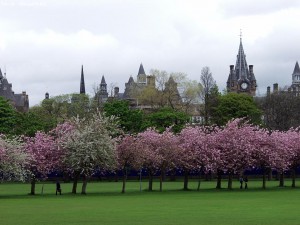Short Term Lets – a Problem
 All Short term lets in Edinburgh will now require planning permission and then a license.
All Short term lets in Edinburgh will now require planning permission and then a license.
We are objecting to STLs in properties with shared entrances such as tenements for the following reasons.
1. Nuisance caused to other residents within the block:
a) Disturbance and noise – short-term lets bring an increased level of noise and disturbance. The groups occupying the property on a short-term basis are almost always on holiday with the associated holiday mindset seven days a week. Most properties in Scotland do not have carpeted entrances and hallways as hotels do, so the banging of suitcases at all hours and the excited chatter of customers echoes at entrances and in hallways. There is additional noise and disturbance as groups bring their belongings in and out of properties, including dragging suitcases and banging them off walls and doors, damaging the paintwork. Cleaners and greeters attend to turn over each property between every short-term let, which can mean banging and vacuuming past midnight. Cleaners and laundry companies may leave trip hazards in shared areas such as large laundry bags. Some letting agencies offer “luggage drop off” services where suitcases are then left in common stairs to be retrieved by customers later.
b) Anti-social behaviour – Neighbours of short-term lets are almost guaranteed to experience anti-social behaviour from customers. Alcohol is a regular contributing factor which makes these situations particularly unpredictable and intimidating to deal with. Regular complaints have been made relating to waste disposal, parking issues, noise, people returning late at night or arriving early in the morning, customers ringing.
c) Security – The security of communal spaces is completely lost. Neighbours cannot tell who is supposed to be in the property and who is not, or who has keys to shared areas. The insecurity of a shared building is advertised by key safes which are installed without permission from neighbours or listed building consent. One doorway in this area has nine key boxes on the doorframe. There is evidence that short-term let customers are more likely to leave shared entrance doors open, which has resulted in residents coming home to unknown people using drugs, and engaging in other antisocial or threatening activities in their mutual shared areas. Residents of flats or properties with shared gardens are forced to share communal but still private areas of their homes with fee-paying strangers who they have never met before and are unlikely to meet again.
d) Overcrowding Short-term rentals often bring more than the advertised number of customers. Groups will also often invite their friends to visit and enjoy their short-term let bringing additional disturbance. Short-term let businesses often advertise for far more customers to stay than would normally reside in a property in relation to its size. In some instances, STLs have been used as party flats.
e) Waste disposal – Recycling is rarely carried out. Communal bins are often used and permanent residents are expected to manage putting out and collecting bins on behalf of the absent owners. Rubbish bags are often left out in communal stairs. Cleaners usually clean inside the short-term let properties but do not usually clean any shared areas. This leaves the residents to clear up after the customers or live in a poorer quality environment.
f) Mental health impacts – Residents draw huge comfort from a home which has a basic level of familiarity, stability and security. The regular intrusion of transient pleasure-seeking strangers is deeply unsettling. Neighbours of short-term lets regularly describe feeling acute stress, anxiety and other mental health impacts. This disproportionately impacts on disabled people, people with long term health conditions, people who live alone, children and young people.
2. An over-concentration of STLs in the Tollcross area and its consequences,
The very high concentration of STLs (coupled with increasing student residences) in central Edinburgh has consequences for the nature of the area and its demography. Parts of the centre are no longer part of a living city and have lost a large proportion of long-term residents. Some residents are being driven out of the city. Far too many tenements now have a majority of flats used as STLs. Furthermore, this causes a loss of facilities and shops that long-term residents rely upon and their replacement with facilities and shops that support tourists but not residents. This was a major reason given by residents moving out of Amsterdam.
The use of so many properties as STLs has an effect on property prices and rent levels with many residents on modest incomes no longer able to live in Edinburgh which we all acknowledge has a serious housing crisis.

Leave a Reply